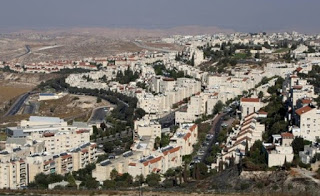
Israel is reeling from the passing of the controversial resolution UNSC 2334 last week. The resolution which passed without the usual US veto, ‘breaks new ground’ by declaring all Israeli settlement on the land east of the 1967 Green line ‘illegal’. Time to revisit the Clash of Cultures blog on this fraught subject. The reality on the ground is far more complex than the international community believes.
A Jewish ‘settlement’
The idea that the territories beyond the Green Line should be Jew-free received a ringing endorsement from Palestinian Prime Minister Mahmoud Abbas just as US secretary of state John Kerry sat Israelis and Palestinians down to peace talks in Washington DC. Not a single Israeli would be allowed in a Palestinian state, Abbas announced.
Like the Palestinians, the EU assumes that the West Bank, East Jerusalem and the Golan Heights are ‘Arab land.’ But nothing is ever that simple in the Middle East. Land ownership is a tangled web, although that”s a point not often made by the Israeli government.
The Golan Heights are almost universally considered ”Syrian” territory and yet the Jewish National Fund lays claim to 73,974 dunams in southern Syria. The earliest purchase was made in the 1880s.
Similarly, land ownership in Jerusalem and the ”West Bank” is far more complex than the EU thinks. The ”Jewish settlements” north of Jerusalem, Atarot and Neve Yaakov, were evacuated in 1948. Mount Scopus – technically in ”Arab” East Jerusalem – remained a Jewish enclave in Jordanian-controlled territory.
It is also little known that hundreds of thousands of Arab squatters in ”Arab East Jerusalem” live on land still owned by the Jewish National Fund. The JNF purchased hundreds of individual parcels of land in and around Jerusalem during the 1920s, 1930s and 1940s. In 1948, on one of these parcels the UN built the Kalandia refugee camp. The Deheishe refugee camp south of Bethlehem was also built on JNF land.
In the 1920s and 30s Iraqi and Iranian Jews queued up to buy parcels of JNF land; after the 1948 war, they were cut off from their purchases when these came under Jordanian rule, as Gil Zohar explained in his 2007 Jerusalem Post piece. In total 145,976 dunams (I dunam = 1,000 sq. m) of Jewish land is said to have come under Jordanian control. (Jewish property claims against Arab countries by Michael Fischbach, p 85).
In Abu Dis, the site of the putative Palestinian parliament, some 598 dunams of land are actually Jewish-owned as even Palestinian organisations acknowledge.
During the 1920s and 30s the ‘Agudat HaDayarim’ Jewish Cooperative Society was established in Jerusalem in order to create Jewish neighbourhoods outside the Old City. The Society had over 210 members, from all walks of life and ethnic backgrounds – including Persian, Iraqi and Yemenite Jews. In 1928 the Aguda purchased 598 dunams of land on the city outskirts in Abu Dis in order to build a ‘Garden Community’ (homes with agricultural plots). Although it acquired a legal title to the area, the Arab revolts of 1929 and 1936-9 prevented the Aguda from establishing the new community. The War of Independence resulted in the Jewish-owned lands in Abu Dis coming under the control of the Jordanian Custodian of Enemy Property.
Another 16,684.421 dunams of Jewish land in the rural West Bank – including the Gush Etzion settlements, land between Nablus, Jenin and Tulkarm, and in Bethlehem and Hebron – were seized by the Jordanians after 1948.
Even before 1948, riots and massacres caused Jews of the centuries-old Yishuv to evacuate their homes in Hebron and parts of Jerusalem.
Before it fell to the Arab Legion in 1948, Jerusalem had a Jewish majority. The first refugees from eastern Jerusalem were Jews from the Shimon Hatzaddik quarter – the site of the tomb of Simon the High Priest. The Old City of Jerusalem became ”judenrein” as thousands of Jews were expelled, leaving their property behind. The Old City was ransacked and some 58 synagogues were destroyed during the 19-year Jordanian occupation. Jews were banned from their holiest places.
There is a respectable body of opinion which argues that most Israeli settlements are legal. Even if Israel were to agree that the Jewish settlements stigmatized by the EU are illegal under international law, the proportion of land ”built on Arab land” in the West Bank represents a tiny fraction of the Jewish-owned land abandoned or seized as a matter of deliberate policy in Arab countries.
The issue of Jewish settlements has to be seen in the context of the mass exchange of land and population between Jews and Arabs across the entire region.

Leave a Reply